Sourdough
FNH-00061 View this publication in PDF form to print or download.
Sourdough, a yeasty starter for leavening hot cakes, waffles, muffins, bread and even
cake, is also a word for an Alaska old-timer. For these early Alaskans, who lived
alone or in small groups of three or four while mining, trapping or homesteading,
sourdough became their staff of life. Bread could not be made without it, so the starter
became a precious possession.
Food supplies came once or twice a year by ship. The food supplies were off-loaded to small boats, river steamers, dogsleds or backpacks to reach remote coastal or Interior Alaska destinations. Orders were placed a year in advance and foods were selected for keeping qualities as the arrival time often proved uncertain.
If yeast supplies ran out, replacements could be a long time in coming, especially if unseasonable ice formation and heavy wind or seas delayed a ship's entry into rivers or ports of call. Ordinary yeast plants, sensitive to the extreme cold, refused to grow well, while the combination of wild or adapted yeast in the sourdough starter proved as tough as its old-timer namesake. Or did the old-timer resemble and get his name from the indomitable sourdough starter? Choose whichever theory you prefer.
Sourdough Starters
A good starter contains only flour, water and yeast. It has a clean sour odor. When it stands several days, the liquid will separate from the batter. This does not matter; just stir it in and feed it.
Starters can be made from any type of flour. However, the type of flour used will make a difference in flavor and how it works in recipes. The recipes in this publication use wheat flour.
Commercial sourdough starters are dried and powdered. Adding water brings it to life. In growing, the yeast gives off carbon dioxide gas, which forms bubbles in sourdough or any other yeast dough.
To start sourdough
You can make your own starter and sponge with this simple recipe:
- 2 cups flour
- 2 cups warm water
- 1 package dry yeast
In a quart-size bowl, dissolve yeast in ¼ cup warm water. Add the remaining water and flour and mix well. Place on a plate (to catch any overflow) and put in a warm place or cupboard for 6 to 8 hours.
Set aside ½ cup of the bubbly starter (to store or feed and use again). The remaining 3½ cups of starter can be used for making pancakes, waffles, muffins, bread or cake immediately.
Sourdough can also be started by trying to capture wild yeast. This method is not discussed in this publication.
If you have a starter — set the sponge
To set the sponge, place ½ cup of starter in a medium-size mixing bowl. Add equal parts flour and water to feed the yeast. For example, add 2 cups water and 2 cups flour. Beat well and set in a warm place, free from draft, to develop for 6 to 8 hours. The sponge will have gained half again its bulk, will be covered with air bubbles and have a pleasant yeasty odor. The sponge can now be used in recipes for pancakes, muffins, bread or cake.
Storing the starter
Before using the active starter, place ½ cup in a scalded pint jar, cover and store
in the refrigerator or a cool place for future use. Leave lots of room for 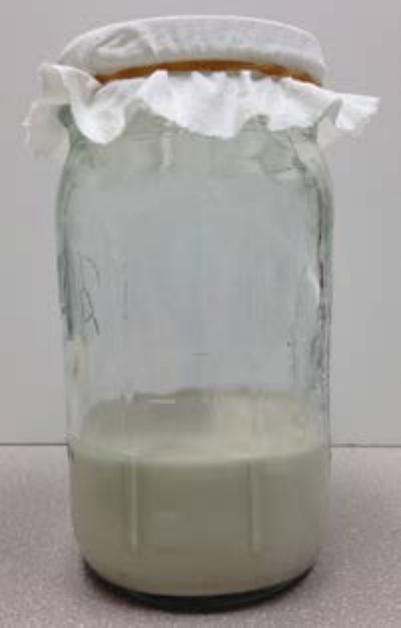 expansion in the container, or put the lid on without tightening it. Starter will
keep well in a clean, covered glass container in the refrigerator. Use of metal containers
or spoons is not recommended as the acid may react with the metal. After removing
the starter from the refrigerator, let it come to room temperature before adding the
flour and water.
expansion in the container, or put the lid on without tightening it. Starter will
keep well in a clean, covered glass container in the refrigerator. Use of metal containers
or spoons is not recommended as the acid may react with the metal. After removing
the starter from the refrigerator, let it come to room temperature before adding the
flour and water.
Old-timers added enough flour to their starter to shape it into a ball and then put it in a sack of flour for easy carrying.
Drying and reconstituting a starter
Sourdough starter may be dried for easy storing or sharing. To dry, drop by teaspoonfuls on parchment paper. Turn frequently until completely dry. In Interior Alaska, drying takes about 24 hours. Store in a covered jar or airtight plastic bags.
To reconstitute a starter, crumble two or three circles of starter in ½ cup of warm water. Let stand overnight or until bubbly. Add ½ cup water and ½ cup flour. Stir. Let stand for a second night or until bubbly. Use to prepare the sponge as directed in recipes.
Sharing your starter
To increase your supply of starter, set the sponge as directed above. Six to 8 hours later, instead of preparing a sourdough recipe, remove your portion of starter as usual, then place ½ cup portions of the starter in clean glass or pottery containers for sharing.
Using baking soda in sourdough recipes
Baking soda is added to react with the acids that result from the reaction of the yeast. This forms gas, which makes the batter lighter. If too much baking soda is added, the product may taste bitter and will be quite brown when baked. If too little baking soda is used, the product may be too sour in taste. Add the baking soda just before baking. In any sourdough recipe it is most helpful to reserve 1 tablespoon of the liquid to dissolve the baking soda. Add this to the batter last, mix thoroughly and bake. Baking soda added directly to the starter may kill the yeast.
Sourdough Hotcakes, Waffles & Muffins
Sourdough Hotcakes
Sourdough hotcakes differ from other hot cakes because a sponge is leavened with the yeast from the sourdough starter and baking soda. The sponge must be set the night before it is to be used.
- 2 cups sponge (active sourdough)
- 1 egg
- ½ teaspoon salt
- 1 tablespoon sugar
- 4 tablespoons nonfat dry milk powder (optional)
- ½ teaspoon baking soda
- 1 tablespoon water
In the evening, or 6 to 8 hours before using, set the sponge. When the sponge is bubbly and active, measure 2 cups for this recipe; save remaining for starter.
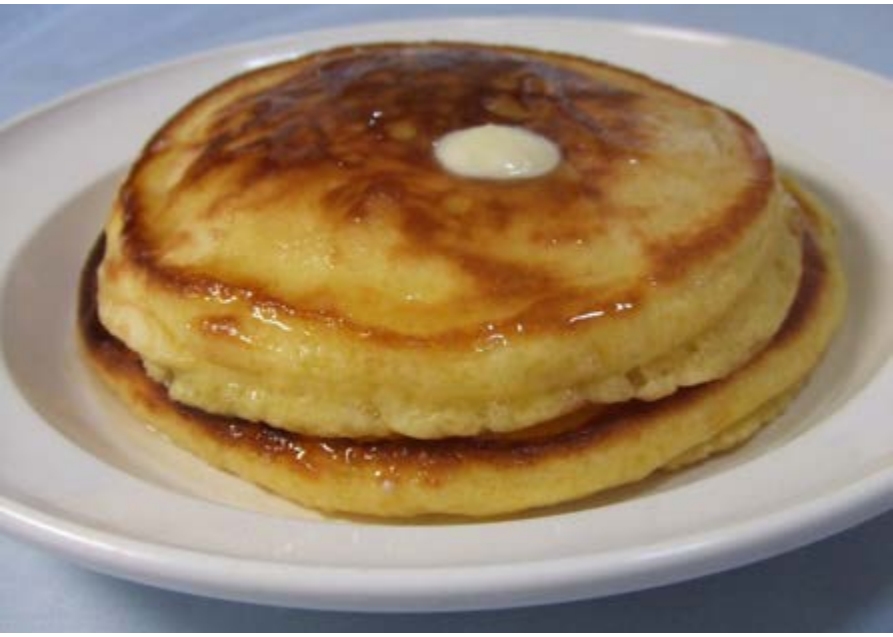
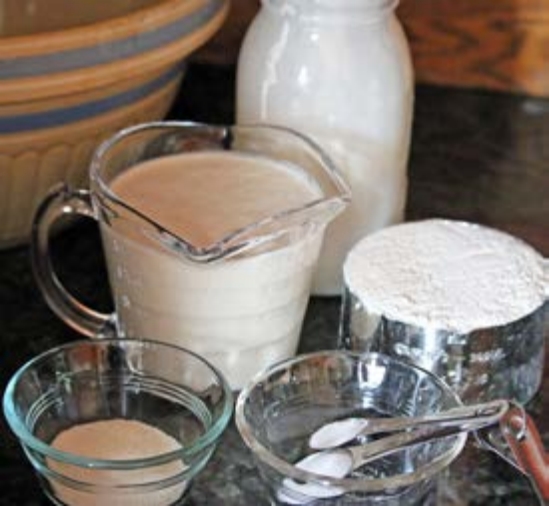 Add to the active sourdough sponge the egg, salt and sugar; beat with a fork to blend
in all ingredients. If you like, add nonfat dry milk powder (optional). Dissolve baking
soda in water and stir the baking soda-water mixture into batter just before baking.
Bake on a hot griddle. Turn once. Serve with hot brown sugar syrup or honey and melted
butter. Molasses, jelly, birch syrup or rose hip syrup are other tasty toppings.
Add to the active sourdough sponge the egg, salt and sugar; beat with a fork to blend
in all ingredients. If you like, add nonfat dry milk powder (optional). Dissolve baking
soda in water and stir the baking soda-water mixture into batter just before baking.
Bake on a hot griddle. Turn once. Serve with hot brown sugar syrup or honey and melted
butter. Molasses, jelly, birch syrup or rose hip syrup are other tasty toppings.
For interesting variations add ½ cup whole wheat flour, cornmeal, wheat germ or bran flakes to the batter. Add another egg to provide the liquid for this addition.
If you prefer a thin pancake, add another egg or a bit more water; for a thicker cake, the sponge should have more flour. At the time of baking, the batter for sourdough should be the same consistency as the batter for other hot cakes that are family favorites.
Sourdough Waffles
Use the basic hot cake recipe, but add 3 tablespoons of oil. Add the oil, then the baking soda-water mixture and bake at once, following the directions that come with your waffle iron.
Sourdough Muffins
- 2 cups sponge (active sourdough)
- 1 egg
- ½ cup vegetable oil or melted butter
- 1 teaspoon salt
- ¼ cup nonfat dry milk
- 1 cup flour
- ½ cup sugar
- ½ teaspoon baking soda
- 1 tablespoon water
- ¾ cup raisins, blueberries or cranberries
In the evening, or 6 to 8 hours before using, set the sponge. When the sponge is bubbly and active, measure 2 cups for this recipe; save remaining for starter.
Mix egg and oil thoroughly with the active sponge. Sift dry ingredients (salt, dry milk powder, flour and sugar) into a separate bowl. Make a well in the center; add wet mixture to the well in the flour. Stir only enough to moisten the flour. Dissolve baking soda in water. Add the baking soda-water mixture and raisins or berries to the batter just before filling the muffin tins. Fill greased muffin tins ¾ full. Bake in 375°F oven for 30 to 35 minutes. Makes 12 muffins.
Oatmeal Berry Muffins
- ¾ cup sponge (active sourdough)
- 1 egg
- ½ cup milk (or 3 tablespoons dry milk + ½ cup water)
- ½ cup oil
- 2 teaspoons grated orange peel
- 1½ cups flour
- ½ cup oatmeal
- ½ cup brown sugar
- ½ teaspoon salt
- ½ teaspoon baking soda
- 1 teaspoon water
- ½ cup blueberries or cranberries
- muffin pan
In the evening, or 6 to 8 hours before using, set the sponge. When the sponge is bubbly and active, measure ¾ cup for this recipe; save the rest for the next starter or use for another recipe.
Grease muffin tins; set aside. Preheat oven to 375°F.
Mix egg, milk and oil thoroughly with the active sponge. Stir in the orange peel.
Whisk dry ingredients (flour, oatmeal, brown sugar and salt) together in a separate
bowl. Make a well in the center; add wet mixture to the well in the flour. Stir only
enough to moisten the flour. Mix the baking soda and water. Quickly stir the baking
soda-water mixture and the berries into the batter. Fill the muffin tins ¾ full. Bake
in preheated 375°F oven for 30 minutes. Makes 12 muffins.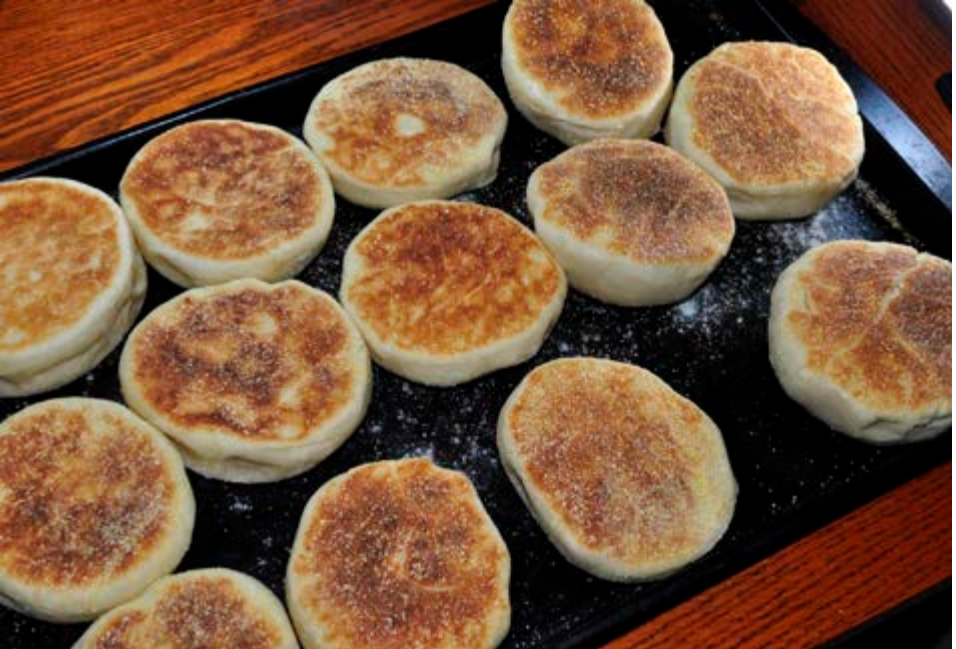
Sourdough English Muffins
- 1 cup sponge (active sourdough)
- ¾ cup milk or buttermilk
- 2¾ cups flour
- 6 tablespoons cornmeal, divided
- ½ teaspoon baking soda
- ½ teaspoon salt
In the evening, or 6 to 8 hours before using, set the sponge. When the sponge is bubbly and active, measure 1 cup for this recipe; save remaining for starter.
Mix together the active sourdough sponge and milk. Combine flour, 4 tablespoons cornmeal, baking soda and salt in a separate bowl. Add to sourdough mixture. Stir to combine well. Turn onto a lightly floured board and knead until smooth and elastic. Roll dough to ½ inch thick and cut with a 3-inch cutter. Sprinkle waxed paper with remaining cornmeal and place the muffins on the cornmeal. Sprinkle with more cornmeal, cover and let rise about 45 minutes. Bake on a medium-hot, lightly greased griddle for 20 to 30 minutes. Turn often. Cool. Split and toast. Serve with butter and blueberry jam. Makes 12 to 14 muffins.
Sourdough Bread
For all bread recipes, set the sponge and let stand in a warm place overnight or for 6 to 8 hours. Save ½ cup sponge for next starter.
Sourdough Bread
- 2 cups sponge (active sourdough)
- 2 tablespoons vegetable oil
- 2 cups flour (or more)
- 2 tablespoons sugar
- 1 teaspoon salt
In the evening, or 6 to 8 hours before using, set the sponge. When the sponge is bubbly and active, measure 2 cups for this recipe; save remaining for starter.
Mix oil thoroughly with active sourdough sponge. Sift dry ingredients (flour, sugar and salt) into a separate bowl; make a well in the center. Add wet mixture to the well in the dry ingredients. Add enough flour to make a soft dough for kneading. Knead on a floured board for 10 to 15 minutes. Place in a greased bowl. Cover with a towel and let rise in a warm place for two to four hours or until doubled in size. Shape dough into loaves in bread pans and set aside to rise. When doubled, bake at 375°F for 50 to 60 minutes. The loaf is done when a thermometer placed in the center registers 200°F.
Casserole Bread
Use the same ingredients and methods as for Sourdough Bread. Instead of kneading the dough, beat it 2 minutes at medium speed setting of the mixer or 300 strokes by hand. Let stand in mixing bowl until double in bulk. Add ¼ teaspoon baking soda dissolved in 1 tablespoon warm water. Mix 30 seconds, turn into greased casserole or loaf pan and let stand 40 minutes. Bake as for Sourdough Bread. Bread is done when crust sounds hollow when tapped and when a thermometer placed in the center of loaf registers 200°F.
Sourdough Whole Wheat Bread
- 2 cups sponge (active sourdough)
- 2 cups whole wheat flour (or more)
- 2 tablespoons sugar
- 1½ teaspoons salt
In the evening, or 6 to 8 hours before using, set the sponge. When the sponge is bubbly and active, measure 2 cups for this recipe; save remaining for starter.
Combine ingredients in a large bowl and mix well with a wooden spoon. This dough will be sticky. Set in a warm cupboard for 2 hours or more. Turn out on a warm, well-floured board.
Knead ½ cup whole wheat flour into the dough for 10 to 15 minutes. Add more flour when kneading, if necessary, for the dough to feel firm but still have moisture in it. Shape into a round loaf and place in a well-greased bread pan. Grease sides and top of loaf, cover with a towel and let rise 1 hour or until doubled. Bake in a preheated oven at 450°F for 10 minutes, then reduce heat to 375°F and bake 30 to 40 minutes longer. The loaf is done when thermometer placed in the center registers 200°F. Makes 1 large loaf.
Sourdough French Bread
Prepare as for Sourdough Bread, but add 1 tablespoon yeast to the starter. Shape into 2 loaves by dividing the dough in half. Roll each half into a 15×12-inch rectangle. Wind up tightly toward you, beginning with the wide side. Seal edges by pinching together. Place rolls diagonally on greased baking sheets that have been lightly sprinkled with cornmeal. Let rise until doubled, about 1 hour. Brush with cold water. Cut with scissors or knife to make one or two lengthwise or several diagonal ¼-inch- deep slits across tops of loaves. Place baking sheets in a hot (400°F) oven with a pan of boiling water placed on a rack below the bread. Bake 15 minutes. Remove from the oven and brush again with water. Reduce the temperature to 350°F and bake 35 to 40 minutes until golden brown. Brush a third time with cold water and bake 2 to 3 minutes longer. The loaf is done when thermometer placed in the center registers 200°F. Makes two French loaves.
Note: The addition of the commercial dry yeast helps give a lighter, airier texture to the bread.
Scandinavian Sourdough Rye Bread
- 2 tablespoons yeast
- 1½ cups warm water (110°F
- 1 cup sponge (active sourdough)
- 3 cups rye flour
- ½ cup molasses
- 2 tablespoons grated orange peel
- ¼ cup oil
- 1 teaspoon crushed fennel or caraway seed (optional)
- 1 tablespoon salt
- 2 cups flour
- additional flour, as needed
In the evening, or 6 to 8 hours before using, set the sponge. When the sponge is bubbly and active, measure 1 cup for this recipe; save remaining for starter.
Dissolve yeast in water. Add active sourdough sponge, rye flour and molasses. Beat well, about 3 minutes. Cover and let rise in a warm place until about double in bulk.
Combine sourdough/rye mixture with remaining ingredients using 2 cups flour. Turn out on a floured board and knead well, adding additional flour to make a smooth, satiny dough. Shape round or oval loaves. Cover and let rise. Slash and bake in preheated 375°F oven for 35 to 40 minutes. When done, loaves sound hollow when tapped and thermometer placed in the center registers 200°F. Cool on wire racks.
Sourdough Pizza Crust
- 2 cups sponge (active sourdough)
- ¼ cup olive oil
- ½ teaspoon salt
- ½ teaspoon baking soda
- 2 cups flour, divided
In the evening, or 6 to 8 hours before using, set the sponge. When the sponge is bubbly
and active, measure 2 cups for this recipe; save remaining for starter. Add oil, salt
and baking soda to sourdough and mix well. Stir in 1 cup flour. Add an additional
cup of flour or enough to make a soft satiny dough. Knead well. Let dough rest about
15 minutes then roll out into rounds. Let rise again while preparing toppings. Add
toppings. Bake in a preheated 425°F oven on the bottom rack for 20 to 25 minutes.
Biscuits, Tortillas & Crackers
Sourdough Biscuits
- 1½ cups sponge (active sourdough)
- ¹⁄3 cup vegetable oil
- ½ teaspoon salt
- 1 tablespoon sugar
- ½ teaspoon baking soda dissolved in 1 tablespoon warm water
- 1½ cups flour
- 1 teaspoon baking powder
In the evening, or 6 to 8 hours before using, set the sponge. When the sponge is bubbly and active, measure 1½ cups for biscuits; save remaining for starter. Stir oil, salt, sugar and baking soda dissolved in water into active sourdough sponge until combined. Add flour and baking powder, stirring to form a soft dough. Turn out on a floured board and knead lightly 8 to 10 times. Roll or pat out to ½ inch thick. Cut into rounds and place on a greased baking sheet. Bake at 425°F for 15 to 20 minutes.
Sourdough Tortillas
- ²⁄3 cup sponge (active sourdough)
- 2 tablespoons vegetable oil
- ²⁄3 cup very hot water
- 3 cups flour
- 1 teaspoon salt
Combine all ingredients until a soft dough forms. If the dough is too sticky, add a bit more flour. Knead well. Divide into 8 pieces and roll into thin circles. Cook tortillas on a hot griddle until they bubble and dark spots appear on the underside. Turn and cook on the opposite side until done.
Sourdough Sesame Crackers
- ½ cup sponge (active sourdough)
- 2 tablespoons vegetable oil
- 1 teaspoon salt
- 1 cup whole wheat flour
- ¼ cup sesame seeds (preferably unhulled)
Preheat oven to 400° F.
To the frothy sourdough starter, add the oil, salt and as much of the flour as you can work in. Turn dough onto a floured board and let it rest a few minutes covered with a damp cloth. Knead in the sesame seeds. Add more flour as needed.
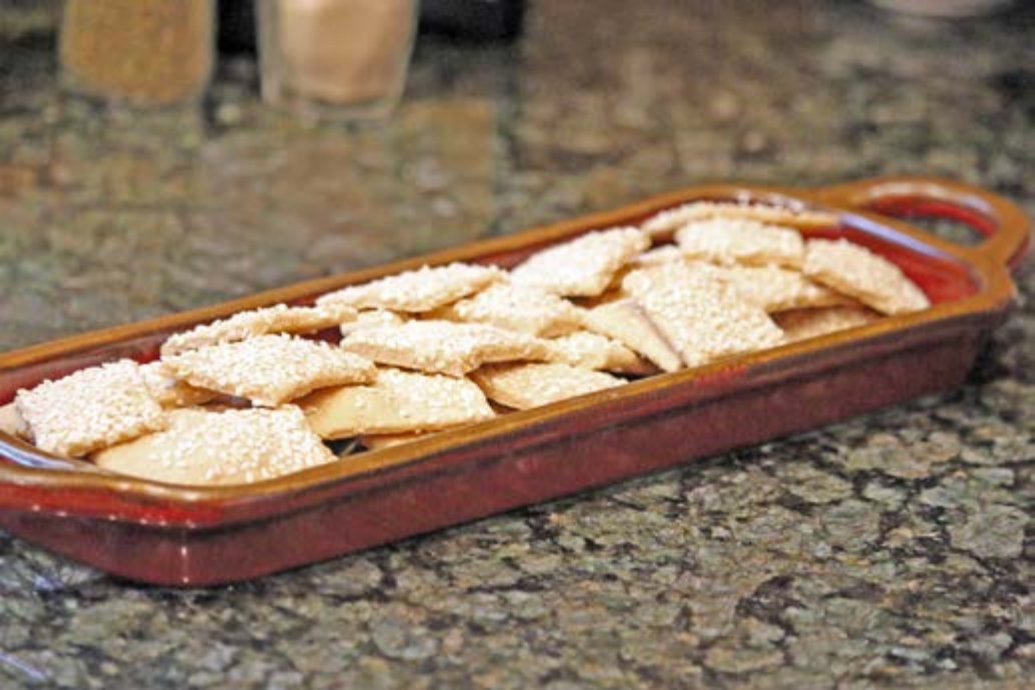
When the dough is stiff, roll it out to a thickness of ¹⁄16 of an inch. Cut the crackers into 1×2-inch rectangles and place on an ungreased cookie sheet. Leave space between each cracker. Prick with a fork and bake for about 8 minutes. The crackers should brown lightly.
Remove from cookie sheet to wire racks to cool. When cool, store in an airtight container.
Desserts
Sourdough Chocolate Cake
- ½ cup thick sponge (active starter)
- 1 cup water
- 1½ cups flour
- ¼ cup nonfat dry milk powder
Mix and ferment 2 to 3 hours in a warm place until bubbly and there is a clean sour milk odor.
- 1 cup sugar
- ½ cup oil
- 1 teaspoon vanilla
- ½ teaspoon salt
- 1 teaspoon cinnamon
- 1½ teaspoons baking soda
- 2 eggs
- 3 1-ounce squares melted chocolate (semisweet, unsweetened or dark)
Combine sugar, oil, vanilla, salt, and cinnamon. Add eggs one at a time, beating well after each addition. Combine wet mixture and melted chocolate with sourdough mixture. Add baking soda. Stir 300 strokes or mix with an electric mixer at low speed until blended. Pour into two well-greased 8-inch round pans or one 9×12-inch rectangular pan. Bake at 350°F for 25 to 30 minutes. Cool and frost with Butterscotch-Chocolate frosting or other icing of your choice.
Butterscotch-Chocolate Frosting — In saucepan combine three 1-ounce squares of unsweetened chocolate, ¼ cup butter or margarine, ½ cup light cream, ⅔ cup brown sugar (packed) and ¼ teaspoon salt. Bring to a boil, stirring constantly; cook until chocolate is melted. Remove from heat; beat in 1 teaspoon vanilla and about 3 cups confectioners' sugar. Spread over top and sides of cake.
Old Fashioned Spice Cookies
- ½ cup sponge (active sourdough)
- ¼ cup vegetable oil
- ½ cup brown sugar
- 1 egg
- ½ cup molasses
- 2 cups flour
- ¼ teaspoon salt
- 1 teaspoon ginger
- ½ teaspoon cinnamon
- ½ teaspoon cloves
- ½ teaspoon nutmeg
- 1 teaspoon baking soda dissolved in
- 1 tablespoon water
Mix together sourdough, oil, brown sugar, egg and molasses in a bowl and set aside. Mix flour and spices together in another bowl. Blend the dissolved baking soda into the sourdough mixture. Add the dry ingredients and mix well. Drop onto a lightly greased cookie sheet and bake at 400°F about 10 minutes.
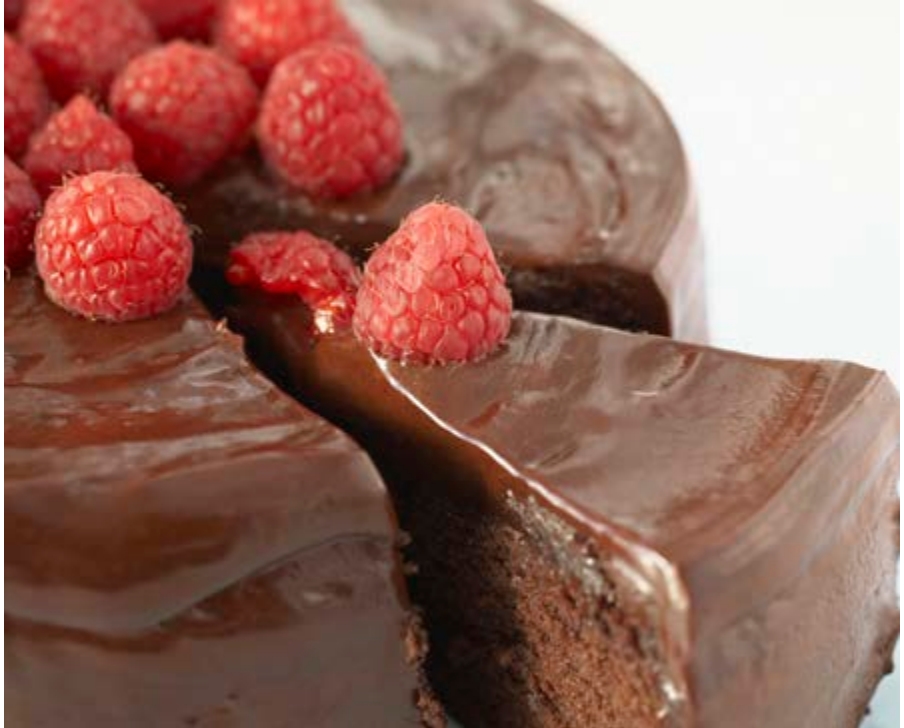
When cool, frost with the following: Stir together 1 cup powdered sugar, ¼ teaspoon maple flavoring and 2 tablespoons milk.
Sourdough Yarns
Various stories tell of the sourdough starter's origin. Below are some of the most credible stories.
Sourdough Pete, when a young man, came to Alaska from Michigan at the turn of the century to seek his fortune. His grandmother, who had pioneered in the Michigan woods, knew a thing or two about hardships in a new land. Her parting gift, a crock of yeast starter for hot cakes and bread, made him famous throughout the land. With the help of a sack of flour, Sourdough Pete always had hotcakes to eat, whether he struck it rich or not. He shared it with friends who, the story tells, walked miles to renew or get a starter of the yeast product. Pete became known for his generosity and his starter, hence his name, Sourdough Pete.
In 1900, an Alaska prospector married an Alaska Native girl. They started a sourdough
pot and kept the starter going by using it regularly. When she died and the husband
became ill, he refused to go to the hospital if he had to leave his sourdough pot.
“It is all I have left of my wife,” he said. It was given to a woman friend to guard.
She kept her promise and used the starter once a week. From it, she gave starters
to countless other Alaskans. It is an especially good starter with a clean aroma and
flavor.
Other stories of sourdoughs' survival in spite of hardships and rigors in the far northern Interior explain that the pot of starter needed to be put bed in the coldest weather. Under the covers, sharing its owner’s body warmth, the starter survived to leaven the next day’s supply of hot cakes. Between camps, it was the last item placed in the pack sack and the first item to be removed upon arrival at the new site.
Another version of the care taken to keep the starter safe on journeys states that the owner wore it in a bag around his neck inside his shirt on long and cold journeys. An old sourdough warns: “If the starter turns orange, it is not spoiled; but if it turns green, it must be discarded.” Modern Alaskans do not use discolored starters but keep the starter clean and fresh in a refrigerator or other cool place and use it weekly.
Tanning Hides
Sourdough has other uses too, as this bit of information from an old trapper explains.
To tan small hides such as mink, rabbit, ermine or muskrat, first wash the hide with lukewarm soapy water, using a mild soap. Lay the skin on a flat board, hair side down. Cover it with a thick batter of sourdough. When dough begins to dry, start working the skin. Rub it with a circular motion against the palm of the left hand. Rub and knead the skin until it is dry and soft.
Julie Cascio, Extension Faculty, Health, Home and Family Development. This publication was first printed in 1958 under the leadership of Lydia Fohn-Hansen.
Revised October 2024
